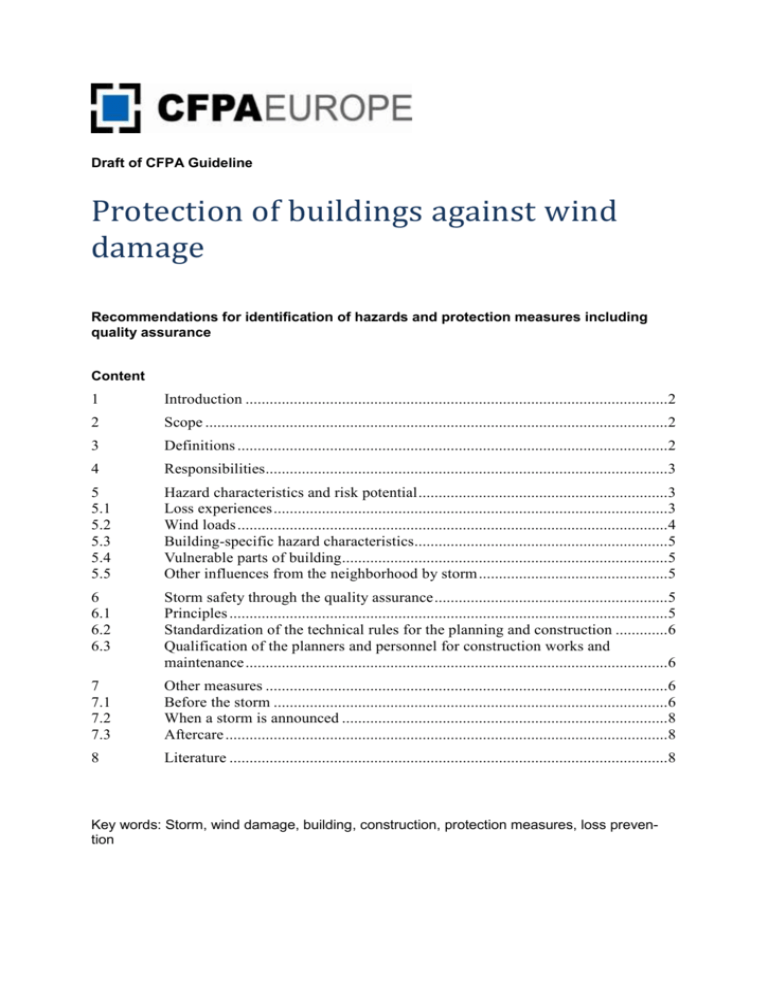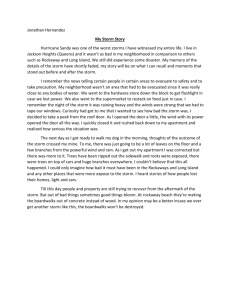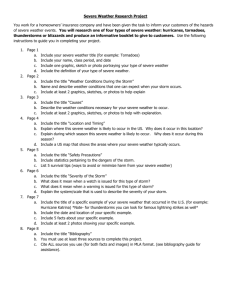Proposal_storm_DrW130131a - CFPA
advertisement

Draft of CFPA Guideline Protection of buildings against wind damage Recommendations for identification of hazards and protection measures including quality assurance Content 1 Introduction ......................................................................................................... 2 2 Scope ...................................................................................................................2 3 Definitions ........................................................................................................... 2 4 Responsibilities .................................................................................................... 3 5 5.1 5.2 5.3 5.4 5.5 Hazard characteristics and risk potential .............................................................. 3 Loss experiences .................................................................................................. 3 Wind loads ........................................................................................................... 4 Building-specific hazard characteristics............................................................... 5 Vulnerable parts of building ................................................................................. 5 Other influences from the neighborhood by storm ............................................... 5 6 6.1 6.2 6.3 Storm safety through the quality assurance .......................................................... 5 Principles ............................................................................................................. 5 Standardization of the technical rules for the planning and construction ............. 6 Qualification of the planners and personnel for construction works and maintenance ......................................................................................................... 6 7 7.1 7.2 7.3 Other measures .................................................................................................... 6 Before the storm .................................................................................................. 6 When a storm is announced ................................................................................. 8 Aftercare ..............................................................................................................8 8 Literature ............................................................................................................. 8 Key words: Storm, wind damage, building, construction, protection measures, loss prevention 1 Introduction This present publication continues the new series of guideline of CFPA Europe on protect against natural hazards. The wind movements by a storm can damage buildings and structures in their current field significantly, due to their very high speed and enormous energy. With the help of proper planning, constructing measures, the continuous monitoring and maintenance both the probability of occurrence and the extent of storm damage can be reduced. 2 Scope In this publication, references to prevent and limit storm damage are systematically concentrated, particularly with regard to building and its constructional components. Therewith building owner and operators, manufacturers, planners, professional staff for construction work and facility management services shall be supported in their actions. [Note: In comparison to flood protection target audiences of the present guideline on protection against storm damage cab been defined clearly. Suggestion from my view: We should address all these groups of people. Accordingly, I have built the proposal of structure] 3 Definitions Storm: A weather-related air flow, which exceeds the strength of the Beaufort scale 8 (62 – 74 km/h). [Note: The definition of storm in European countries may be different] Table 1 Beaufort Scale und wind speed Wind speed Wind intensity (Beaufort Scale) m/s km/h 0 0,0 < 0,3 0-2 1 0,3 < 1,6 2-5 2 1,6 < 3,4 6 - 11 3 3,4 < 5,5 12 - 19 4 5,5 < 8,0 20 - 28 5 8,0 < 10,8 29 - 38 6 10,8 < 13,9 39 - 49 7 13,9 < 17,2 50 - 61 8 17,2 < 20,8 62 - 74 9 20,8 - < 24,5 75 - 88 10 24,5 < 28,5 89 - 102 11 28,5 < 32,7 103 - 117 12 ≥ 32,7 ˃ 117 Tornado: Tornadoes (over land) or waterspouts (over water) are large vortices with a vertical axis, mostly ranging from the edge of a thunderstorm cloud to the ground. Tornadoes are usually classified according to the 6-level Fujita scale, which is defined by the maximum wind speeds. In Europe, the 12-level scale Torro is also common. Table 2 Classification of the Fujita Scale Wind speed Scale m/s km/h F0 < 32,5 64 – 116 F1 32,5 – 50 117 – 180 F2 50 – 70 181 – 253 F3 70 – 92,5 254 – 332 F4 92,5 – 116,5 333–418 Responsibilities 4 All the parties involved in construction are in their particular area of effect responsible for the required safety at the building's use, including − − − − − − building owners and operators, construction designers and planners, construction contractors and workers, auditors and inspectors construction site manager and manufacturers of construction products and systems. This responsibility is regulated by law in some European countries, e. g. such as the Building Code of the federal states in Germany. According to the general conditions and terms for the windstorm insurance, each policyholder obliged to comply with all statutory, regulatory and contractual regulations for safety. All of these responsibilities also apply to structural changes, which may not be subject of building permission, for example, − − − − renovations, changes in the roofing materials, such as roof tiles, roofing, metal roofing installation of additional roof structures, such as: transmission towers installation of solar panels on roofs and façades For this the static against effects of wind must always be checked and verified. 5 Hazard characteristics and risk potential The strength of the wind forces, which can impact on a building and its parts, is substantially depending on the wind flow, the local topographical conditions and adjacent buildings. By installation of solar panels on the roof or the facade of buildings the wind loads on the building and its constructional components can be altered by changes in the external shape of the building, e. g. in case of elevated solar panels. In addition, the fire protection of the roof and the facade can also be affected, because the fixing elements of solar panels fit into the existing structures. 5.1 Loss experiences Due to the prevailing massive building structures in Europe storm damage are mainly recorded in the building envelope, such as roof, windows, and also in peripheral installations. According to the insurer become insured objects in recent years to be more vulnerable against storms and other severe weather by trend, for example to read at the ratio of claims to insurance sum. There are, among other things following reasons: − Structural changes (additions, special detailed design and state of maintenance by roofs and windows) − Using of new building materials (metal, glass, and plastic facades, thermal insulation) − Species, age, height and condition of trees around buildings − Extension of the insurance coverage (e. g. inclusion of damage to gardens, trees, fences and costs for clearance etc.). The vulnerability is consequently not a fixed size. It may change over time and lead to adaptation needs in risk assessments. The loss prevention has therefore an important role in reducing the damage. More examples and meaningful pictures of damage??? Figure 1 After a storm … Figure 2 Scaffolding after a winter storm 5.2 Wind loads Due to the various circulation and pressure effects the design of structures for wind load requires an extensive professional experience by the responsible engineers and architects, as well as the local skilled building workers. For the design of constructional components nationally specifications of the local wind loads exist, which based on meteorological measurements, e. g. height-depending wind speed, and may be possibly summarized in wind load zones. For structures, which are not susceptible to vibration 1, the national standards as the basis for design of constructional component contents usually simplified assumptions and calculation methods to the complex load making wind for the daily work of designer. 5.3 Building-specific hazard characteristics Buildings, which built in a prominent position, are especially exposure to exceptional wind loads. Altitudes (hills, mountain peaks), slopes and locations on the lake or in open areas are particularly exposed. A building location across a possible wind corridor is also unfavorable. Particularly at storm hazards are also − buildings that stand out (e. g. high rack warehouses), − buildings with irregular shapes, e. g. strong textured exterior wall or roof surfaces, − buildings with critical forms that cause flowing effects and additional associated dynamic stresses and − buildings with critical operating conditions, e. g. open building gates. Vulnerable parts of building 5.4 Of exceptional wind loads affected in special degree are constructional components and parts, which are installed on the roof or the façade, e. g. antenna, chimney, solar panels and scaffolding. Also constructional components with low weight are storm endangered. 5.5 Other influences from the neighborhood by storm Bare brickworks are particularly vulnerable by storm. This affects not only half-finished walls, scaffolding, or rafters. Also, the material on the site can be tossed by a storm. During storm may hazards also come from trees on the property, especially by overhanging branches, fine roots and rotting. Therefore the trees on the property should be preferably checked twice a year. A professional should be consulted if a reliable assessment of tree condition is only sufficient in this way. Storm safety through the quality assurance 6 With protective measures storm damage can be avoided and limited according to experience, both in the terms of the probability of occurrence and the extent of damage. These measures are partly required due to the statutory provisions, e. g. in terms of safe design of constructional components for the normalized wind loads and recognized technical rules (See also section 6.2). In addition, other measures can also contribute to loss prevention, which to be taken each before or after a storm and when a storm is announced (See also section 7). 6.1 Principles Building structures are still designed to withstand a certain wind load as the design load and may only fail when the actual wind load exceeds the design load. They must be planned not only in accordance with the recognized technical rules, but also constructed and maintained in proper form. For roofs the roof form, the format and the material properties of the roofing or waterproofing membrane are also to be considered in this context. 1 As not susceptible to vibrations apply structures e. g. in accordance with DIN 1055 where the deformations under the dynamic effect of the wind forces don’t exceed deformations from static wind load by more than 10%. 6.2 Standardization of the technical rules for the planning and construction For the structural design and static calculations against wind loads European harmonized bases are available: − EN 1990 "Eurocode: Basis of structural design" − EN 1991 "Actions on structures" (Eurocode 1), Part 1-4: "General actions – Wind actions" For the installation of roofing, e. g. roof tiles, there are possibly further and differing national rules based on Eurocode 1 to follow. The mounting of constructional components must also be carried out professionally and in accordance with the relevant specifications to the manufacturer and any required approval of the usability. 6.3 Qualification of the planners and personnel for construction works and maintenance Apart from the recognized technical rules as secure foundation for the building design and construction, the qualification of the all construction actors determines due to experience significantly the construction quality. For this different legal, regulatory requirements in some European countries are possibly available. The following recommendations should therefore make an initial guide for project: − The Planner should be according to his expertise and experience suitable for the design and preparation of individual building project. The planner is responsible for the completeness or usability of the design. The planner should ensure that the conditions necessary for the construction of individual drawings, calculations and instructions compliance with the legal requirements. If the planner has not the required expertise and experience on individual subjects, appropriate specialists should be consulted. They are responsible for the planning documents what they developed and have to sign. For the proper coordination and interlocking of all technical plans the planner remains responsible. − Each contractor for construction works should be according to his expertise and experience suitable for the acquired works und should have the necessary equipment and skilled workers. The contractor should be responsible that all of the constructions including the proper setup and safe operation of the site are matching with the legal requirements. The contractor has to submit the necessary approvals about the usability of the used products and systems and kept these on the site. − The site manager should have necessary expertise and experience for his tasks. The site manager should ensure the safe operation, in particular the safe interlocking of all construction works, and has to give the necessary instructions. The responsibility of contractors is not affected. The site manager should be responsible for ensuring that the construction project is carried out in accordance with the legal requirements. 7 Other measures … 7.1 Before the storm Damage on roofs, for example, results regularly the loss of their protection against the cold and wet. Therefore the losses of the building contents especially in commercial and industrial buildings could be much larger. A strong damage or even the loss of the roof may be also weakening the stability of the critical structure so that it can even be completely destroyed. Wind-loaded building components, such as elements of the external walls and facades, roof components and roof systems should be regularly maintained, including their attach- ment. For maintenance, it also means working to eliminate prejudice pollution, such as gutters as the roof drainage system. Defects and damage should be immediate repaired, e. g. − − − − − − − − − aging or corrosion damage, missing or damaged tiles or plates and anchors damaged or broken parts and cracks in the roofing irregular gravel layer on flat roofs damaged roof overhang, pests or rot in wood, broken or bent gutters and downpipes or loose snow guards, cracks in heads, covers and facing of chimney, damaged mounting of the antenna systems or lightning rod broken from their anchorage and − unstable mounting of solar modules, Replacement parts (such as roof sheets and films) should be held in stock, in order to repair the storm-damaged roof quickly and thus to minimize storm damages as possible. Large facade glazing should be divided, when possible, in order to avoid lengthy and costly damage that can occur, for example, by the impact of storm-related debris or hail. Solar panels and collectors that are installed on the façade or roof should be designed and mounted for possible wind loads as in the adjacent roof and facade components. The solar panels and collectors located out of the plane of the facade or the roof, for example by the elevation, the altered flow ratio should be accounted separately in each case, if necessary e. g. by a wind assessment, because the drag coefficient for the elevation is not always determined and therefore not yet listed in the design or calculation rules for constructional components. In order to avoid storm damage by or on scaffolds, the following precautions should be taken: − Secure anchoring of the scaffolding on the buildings; − Additional security measures when using protective films; − Careful observation of the weather forecast and timely stopping of the works if necessary. In order to ensure the safety of cranes in case of storm, it is particularly − to examine the viability of the ground, especially in view of the strong storm one-sided load of the crane, if necessary anchoring with ropes or timely removal of mobile devices, − to anchor the chassis of cranes running on rails surely, e. g. with pins and plates to the rail foundation. Wheel brakes and wheel chocks are less effective, − to release the arm of cranes, in order to allow the orientation with the wind field, without jeopardizing neighbor buildings, − to check the system regularly, in order to identify, repair, and, if necessary, replaced the completed seized, corroded and other unsafe equipment timely. The preparation of a site-or project-specific emergency plan with instructions on proper behavior and emergency management has proven itself in practice. Only a clear definition of responsibilities and detailed planning of necessary actions and processes in case of emergency, allow efficient use of the advance warning. An emergency plan should include the followings: − Information sources about storm warning, such as meteorological service − Clear assignment of responsibilities for the procurement, receiving or forwarding of weather information and − Introduction of the proposed measures − Contact information (e. g. phone numbers) and contact person of assisting agencies (e. g. fire department) − Occupancy of the in-house emergency response team with phone number and responsibilities − Clear description of the measures to be take in case of a storm event, including measures to ensure the supply and disposal, e. g. emergency power supply − Persons and their representatives, who are responsible for the necessary protective measures and for the maintenance of protective equipment − Define and establish of emergency measures to secure property and assets, such as data records and files, where appropriate, establish alternative production sites or buildings and acquisition opportunities − Complete and implement the inspection and maintenance plan, e. g. including the cleaning of drainage holes of roof − Processing updating the emergency plan according to last experiences. Emergency plans should be regularly updated and adapted. These exercises are also essential. They serve to test the plans, to identify weaknesses and errors in the information chain and instructions and to prepare staff for the worst case. 7.2 When a storm is announced The emergency plan should be activated on time. This process should be monitored and supported. The following measures can for example help to prevent and limit the damage: − Close skylights, windows, doors and hatches and shutters − Roll up awnings − Securing mobile objects outside the building, for example, drive your car away from trees, preferably in a garage. − Get yourself and others safe. 7.3 Aftercare When it comes to storm damage despite all the prevention measures, the following rules of behavior are observed: − Announce all the observed damages including the estimated amount of loss first by the insurer without delay − Keep the damage as low as possible secondly through measures such as temporary covering and other protection measures against the ingress of moisture fixe or remove loose parts drying of drenched facilities − Repair the roof by a professional company. It should pay attention to the current regulation and rules of civil engineering, such as reinforced interlocking roof tiles and bricks − If in doubt, the advice of insurer should be requested, who will provide assistance at any time. 8 Literature GDV (German insurance association) Stürmische Zeiten – Schäden vorbeugen und richtig versichern http://www.gdv.de/2008/11/stuermische-zeiten-schaeden-vorbeugen-undrichtig-versichern/ GDV (German insurance association) Sturm – Eine Gefahr für bauliche Anlagen; Planungs- und Ausführungshinweise zur Schadenverhütung (VdS 2389) http://www.vds-industrial.de/fileadmin/vds_publikationen/vds_2389_web.pdf The Loss Prevention Council Recommendations for the assessment of roofs resistance to wind damage …




![My Severe Storm Project [WORD 512KB]](http://s3.studylib.net/store/data/006636512_1-73d2d50616f6e18fb871beaf834ce120-300x300.png)

